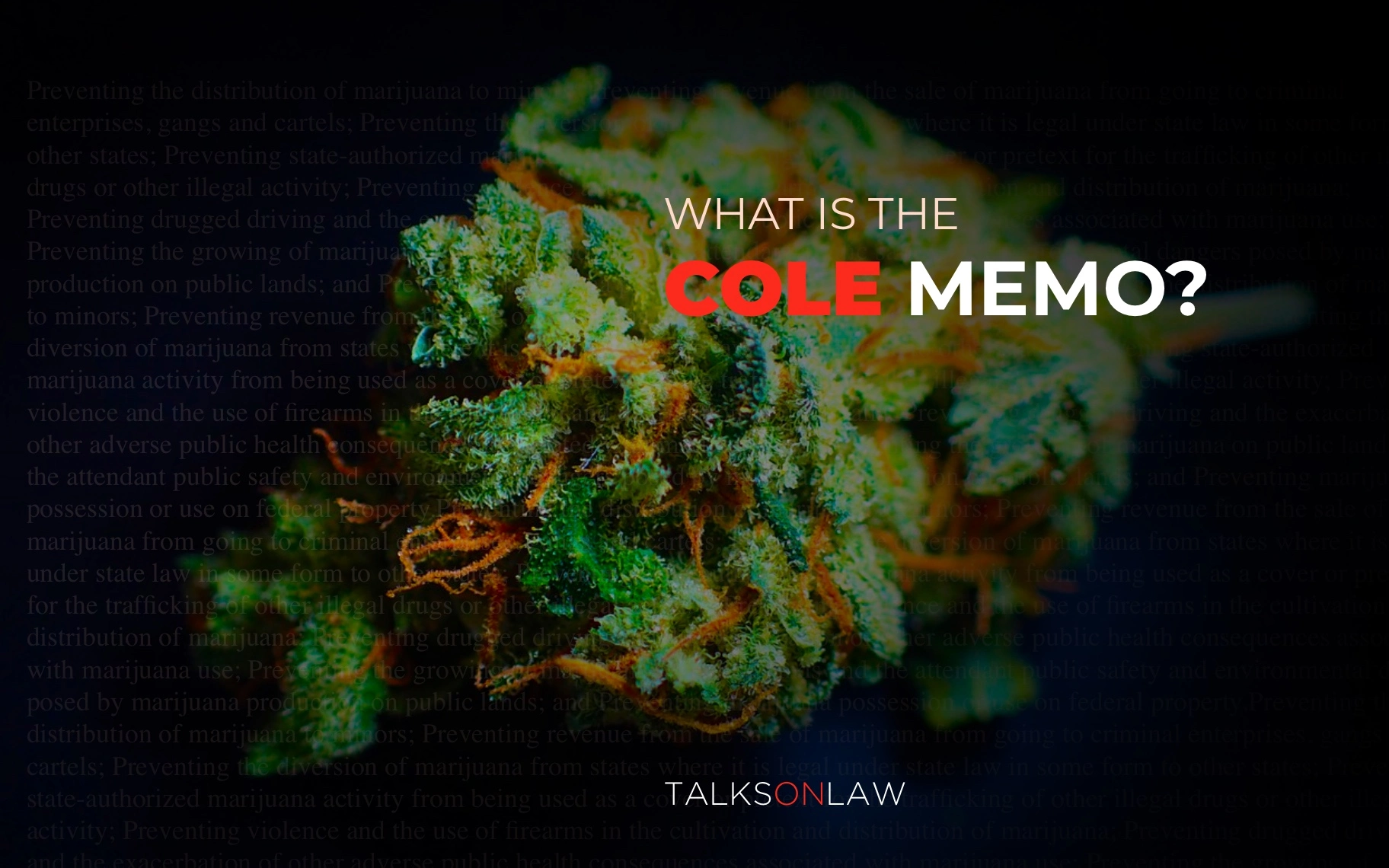
In the dynamic landscape of Canadian cannabis legislation, few documents have wielded as much influence as the Cole Memorandum. Originally crafted in the United States, the memorandum laid out federal enforcement priorities regarding cannabis, providing a framework that has reverberated across international borders, including Canada.
The Cole Memorandum’s significance in the Canadian cannabis landscape cannot be overstated. It served as a touchstone for policymakers, regulators, and industry players alike, shaping the trajectory of cannabis legality and enforcement in the country. Understanding its principles and implications is crucial for navigating the complex web of weed laws that govern the Canadian cannabis industry.
For cannabis businesses, compliance with these laws is not merely a matter of legality but also one of sustainability and growth. Failing to grasp the intricacies of cannabis regulations can result in legal entanglements, financial losses, and reputational damage. Similarly, consumers must be aware of their rights and responsibilities under these laws to ensure safe and legal consumption practices.
In this article, we delve into the Cole Memorandum, unraveling its origins, impact, and ongoing relevance in the Canadian context. By shedding light on this pivotal document, we aim to equip both businesses and consumers with the knowledge needed to navigate the ever-evolving terrain of Canadian weed laws.

The Cole Memorandum, named after former U.S. Deputy Attorney General James M. Cole, emerged against the backdrop of shifting attitudes towards cannabis in the United States. In 2013, amidst a wave of state-level cannabis legalization initiatives, the memorandum was issued to provide guidance to federal prosecutors on how to prioritize enforcement efforts in states where cannabis had been legalized in some form.
Its origins lie in the tension between federal and state laws regarding cannabis. While cannabis remained illegal under federal law, several states had moved to legalize its medical and recreational use. This patchwork of state laws created a legal gray area, prompting the need for federal guidance on enforcement priorities.
The Cole Memorandum exerted a profound influence on cannabis policy and enforcement in Canada, despite being a product of U.S. jurisdiction. As Canada embarked on its own journey towards cannabis legalization, the principles outlined in the memorandum served as a reference point for policymakers and regulators.
One of the key points emphasized in the memorandum was the importance of preventing certain federal enforcement priorities, such as the distribution of cannabis to minors, diversion of cannabis across state lines, and involvement of criminal enterprises. By focusing federal resources on these priority areas, the memorandum sought to provide a degree of flexibility to states in implementing their own cannabis laws while maintaining federal interests.
In Canada, this approach resonated with policymakers grappling with similar challenges in balancing federal and provincial jurisdiction over cannabis regulation. While the Canadian legal framework differed from that of the United States, the underlying principles of prioritizing public health, safety, and preventing illicit activities mirrored those articulated in the Cole Memorandum.
Overall, the Cole Memorandum served as a guiding light for Canadian policymakers navigating the complexities of cannabis legalization. Its influence on shaping enforcement priorities and regulatory frameworks underscores the interconnectedness of global cannabis policy and the need for collaboration and dialogue among nations facing similar challenges.
The impact of the Cole Memorandum on the Canadian cannabis industry transcended borders, influencing not only the legality of cannabis but also the regulatory framework governing its production, distribution, and consumption.
At its core, the Cole Memorandum provided a framework for tolerating state-level cannabis legalization in the United States, outlining federal enforcement priorities that guided prosecutors’ actions. While directly applicable to U.S. jurisdictions, its principles resonated with Canadian authorities grappling with similar challenges in navigating the interplay between federal and provincial cannabis laws.
In Canada, the Cole Memorandum’s influence was evident in the approach taken by authorities towards enforcing cannabis laws. Rather than pursuing a one-size-fits-all approach, Canadian authorities adopted a nuanced stance, prioritizing enforcement efforts based on the memorandum’s outlined priorities. This approach allowed provinces to develop their own regulatory frameworks while ensuring alignment with federal objectives.
Examples of cases or incidents influenced by the Cole Memorandum abound in Canada’s cannabis landscape. One notable example is the regulation of cannabis dispensaries. While dispensaries operated in a legal gray area before federal legalization, authorities often tolerated their presence provided they adhered to certain principles, such as not selling to minors or engaging in criminal activities. This approach mirrored the memorandum’s emphasis on preventing federal enforcement priorities.
Similarly, the regulation of cannabis edibles and concentrates was influenced by the Cole Memorandum’s focus on public health and safety. Canadian authorities imposed strict regulations on these products to mitigate potential risks, such as accidental ingestion by children or diversion to the illicit market.
Overall, the Cole Memorandum played a significant role in shaping the Canadian cannabis industry’s legal and regulatory landscape. Its influence underscored the importance of adopting a balanced approach to cannabis regulation, one that prioritizes public health, safety, and preventing illicit activities while respecting the autonomy of provincial jurisdictions.

Since the introduction of the Cole Memorandum, Canada has undergone significant transformations in its cannabis laws and regulations, culminating in the historic legalization of recreational cannabis in 2018. This evolution reflects a shift towards a more progressive and evidence-based approach to cannabis policy, marked by a departure from punitive enforcement measures towards a system focused on harm reduction, public health, and social equity.
Prior to legalization, cannabis laws in Canada were characterized by prohibitionist policies that criminalized possession, cultivation, and distribution. Enforcement efforts primarily targeted individuals involved in the illicit cannabis market, leading to widespread arrests and convictions, particularly among marginalized communities. The Cole Memorandum served as a reference point for policymakers grappling with the challenges of enforcing cannabis laws in a manner consistent with federal priorities while respecting provincial autonomy.
With the advent of legalization, Canada embarked on a new era of cannabis regulation aimed at balancing public health and safety with economic opportunities and social justice. The Cannabis Act, which came into effect in October 2018, established a comprehensive regulatory framework for the production, distribution, and sale of cannabis for recreational use. This landmark legislation represented a departure from the punitive approach of the past, allowing for the legal sale and consumption of cannabis while implementing strict regulations to mitigate potential risks.
The post-legalization era in Canada has seen a shift in enforcement priorities towards addressing public health concerns, such as preventing youth access and reducing the illicit market’s influence. While cannabis remains subject to regulation and oversight, enforcement efforts have focused more on compliance with licensing requirements and ensuring product safety than on criminalizing individual consumers.
Recent developments in the Canadian cannabis industry point towards a maturing market characterized by increased competition, consolidation, and diversification. Licensed producers have expanded their product offerings to include a wide range of cannabis derivatives, such as edibles, concentrates, and topicals, catering to diverse consumer preferences. Additionally, the emergence of cannabis retail stores has transformed the retail landscape, providing consumers with greater accessibility and choice.
Looking ahead, the Canadian cannabis industry faces both opportunities and challenges. Continued regulatory changes, including the potential expansion of legal cannabis markets and the introduction of new product categories, could unlock significant growth opportunities for businesses. However, challenges such as supply chain disruptions, regulatory compliance, and competition from the illicit market remain key concerns.
Overall, the evolution of cannabis laws and regulations in Canada since the introduction of the Cole Memorandum reflects a broader trend towards progressive drug policy reform. By embracing evidence-based approaches to cannabis regulation and prioritizing harm reduction, Canada has positioned itself as a global leader in the cannabis industry, poised for continued growth and innovation in the years to come.
The Cole Memorandum, while lauded for providing guidance on federal enforcement priorities regarding cannabis, has faced its share of criticisms and controversies regarding its effectiveness and application in Canada.
One criticism leveled against the memorandum is its perceived ambiguity and inconsistency in enforcement practices. Critics argue that the memorandum’s broad principles, such as preventing distribution to minors and diversion to other states, lack clear metrics for measuring compliance, leading to disparate enforcement actions across jurisdictions. This inconsistency has raised concerns among industry stakeholders about the unpredictability of enforcement and the potential for arbitrary decision-making by authorities.
Furthermore, some skeptics question the memorandum’s effectiveness in achieving its stated objectives. Despite efforts to prioritize federal enforcement actions against specific cannabis-related activities deemed harmful, such as illegal trafficking and involvement of criminal enterprises, critics argue that the memorandum has failed to significantly impact the illicit cannabis market or curb criminal activities associated with cannabis production and distribution.
Legal challenges and conflicts have also arisen from the application of the Cole Memorandum in Canada, particularly in cases where provincial cannabis regulations conflict with federal priorities. For example, disputes have emerged over the regulation of cannabis advertising and marketing, with provinces implementing varying restrictions to promote public health objectives, while industry stakeholders argue for greater flexibility to promote their products and brands.
Moreover, the evolving nature of cannabis laws and regulations in Canada has led to uncertainty and confusion among industry participants regarding compliance requirements and legal obligations. Legal challenges, such as disputes over licensing decisions or regulatory interpretations, have added complexity to an already intricate regulatory landscape, raising questions about the adequacy of existing enforcement mechanisms and oversight frameworks.
Perspectives on the Cole Memorandum and its implications vary among industry experts, policymakers, and stakeholders. While some view the memorandum as a valuable tool for guiding enforcement actions and promoting consistency in cannabis policy, others question its efficacy in addressing underlying issues such as public health, social equity, and the illicit market. Industry stakeholders, in particular, advocate for greater clarity and transparency in enforcement practices, as well as ongoing dialogue between federal and provincial authorities to harmonize regulatory approaches and address emerging challenges.
Overall, the Cole Memorandum continues to provoke debates and controversies surrounding its effectiveness and application in Canada’s evolving cannabis landscape. As the industry matures and regulatory frameworks evolve, stakeholders will continue to grapple with the complexities and uncertainties inherent in navigating the intersection of federal and provincial cannabis laws.

Beyond domestic considerations, international agreements and conventions have also influenced Canada’s approach to cannabis policy. These agreements, such as the Single Convention on Narcotic Drugs of 1961 and the United Nations Convention Against Illicit Traffic in Narcotic Drugs and Psychotropic Substances of 1988, have historically placed strict controls on the production, distribution, and consumption of cannabis and other drugs.
Canada’s decision to legalize cannabis for recreational use in 2018 sparked discussions about its compliance with international drug control treaties. While the legalization of cannabis for medical purposes had already raised questions about treaty obligations, the move to legalize recreational cannabis further challenged the status quo.
In response to concerns about treaty compliance, Canada has emphasized its commitment to upholding international drug control conventions while pursuing evidence-based approaches to cannabis regulation. The government has argued that legalization aligns with the overarching goals of these conventions, such as protecting public health, preventing drug abuse, and combating illicit trafficking.
However, some international stakeholders have expressed reservations about Canada’s legalization efforts, fearing that they could undermine global drug control efforts and set a precedent for other countries to follow suit. Critics argue that Canada’s departure from strict prohibitionist policies could embolden other nations to challenge the existing international drug control regime, potentially leading to fragmentation and inconsistency in global drug policy.
Despite these concerns, Canada’s legalization of cannabis has sparked discussions at the international level about the need to modernize drug control conventions to reflect evolving societal attitudes and scientific evidence. Calls for reform, including proposals to reconsider the classification of cannabis and explore alternative regulatory approaches, have gained traction among certain countries and advocacy groups.
In conclusion, international agreements and conventions play a significant role in shaping Canada’s cannabis policy, influencing decisions about legalization, regulation, and compliance. As Canada navigates the complexities of domestic and international drug policy, ongoing dialogue and cooperation with international partners will be essential to reconcile domestic priorities with global commitments and foster a coordinated approach to drug control.
The legalization of cannabis in Canada has not only transformed the legal and regulatory landscape but also sparked broader discussions about its societal impact and public perception.
One notable aspect of cannabis legalization is its potential to challenge long-standing stigmas and stereotypes associated with cannabis use. By destigmatizing cannabis and normalizing its consumption, legalization has encouraged more open conversations about its medicinal properties, therapeutic benefits, and recreational use. This shift in public perception has empowered individuals to make informed choices about cannabis consumption and seek out alternative treatments for various medical conditions.
Moreover, cannabis legalization has had significant implications for social justice and equity. Historically, marginalized communities, particularly Indigenous and racialized groups, have been disproportionately affected by cannabis prohibition, facing higher rates of arrest, incarceration, and criminalization for non-violent cannabis-related offenses. Legalization presents an opportunity to address these disparities by implementing policies that promote equity, inclusion, and social justice, such as expunging criminal records for past cannabis convictions and creating pathways for equitable participation in the legal cannabis industry.
However, challenges remain in addressing the complex social and public health issues associated with cannabis use, particularly among vulnerable populations. Concerns about youth access, impaired driving, and the normalization of cannabis use in public spaces have prompted calls for robust education campaigns, harm reduction strategies, and evidence-based prevention initiatives to mitigate potential risks and promote responsible cannabis consumption.

The Cole Memorandum has played a pivotal role in shaping Canadian weed laws, despite its origins in the United States. Its influence has been felt in the formulation of enforcement priorities and regulatory frameworks, guiding policymakers and regulators in navigating the complexities of cannabis legalization while balancing federal interests with provincial autonomy.
As Canada continues to evolve its cannabis laws and regulations, staying informed about legal developments in the industry is crucial for businesses and individuals alike. The landscape of cannabis policy is dynamic and subject to change, with new regulations, licensing requirements, and enforcement priorities emerging regularly. By staying abreast of these developments, stakeholders can ensure compliance with evolving legal requirements and mitigate the risks associated with non-compliance.
Compliance with regulations is of paramount importance for businesses and individuals operating in Canada’s evolving cannabis market. Failure to adhere to legal requirements can result in severe consequences, including fines, penalties, and even criminal prosecution. Moreover, compliance fosters trust and credibility within the industry, enhancing the reputation and sustainability of businesses over the long term.
In summary, the Cole Memorandum’s legacy serves as a reminder of the intricate interplay between federal and provincial cannabis laws in Canada. By staying informed and prioritizing compliance with regulations, stakeholders can navigate the evolving cannabis landscape with confidence, contributing to a thriving and responsible industry that prioritizes public health, safety, and social equity.
Order weed online in Winnipeg. Puff Wow makes it easy to buy Cannabis online with our secure checkout and fast delivery.
Winnipeg, Manitoba
Canada

